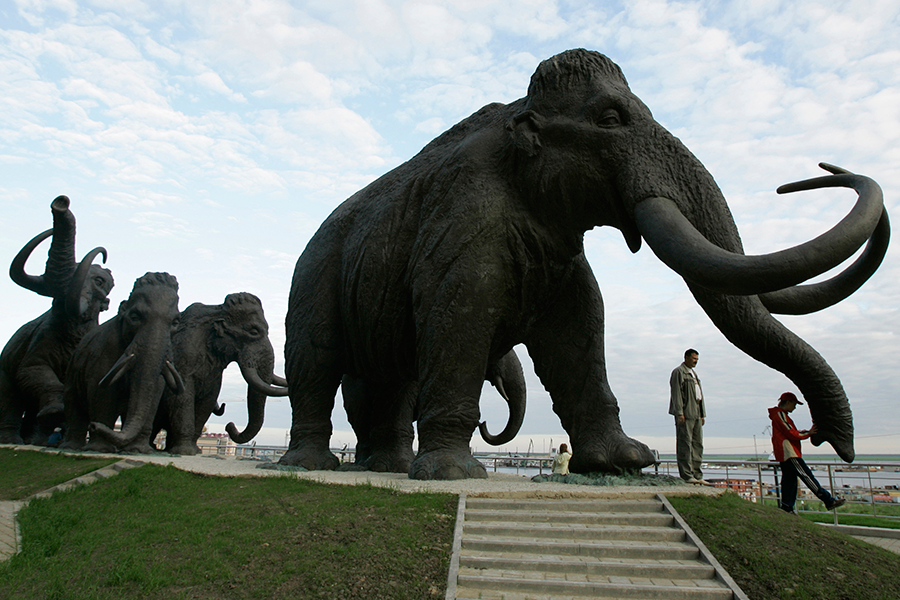We can clone a woolly mammoth. But should we?
This is not your parents' "Jurassic Park."
Harnessing the power of the CRISPR-Cas9 gene editing tool, a team of Harvard researchers is slowly coaxing woolly mammoth-like traits out of normal elephant cells. But recent claims that they’re close to creating a hybrid embryo have raised questions regarding the ethics of the procedure.
The issues range from questions of practicality – Should we risk impregnating an endangered elephant with an experimental embryo? – to an ethical Pandora's box: Would the ability to bring species back from the dead derail conservation efforts?
But geneticist George Church says he believes letting the research continue would produce the benefits that go beyond the chance to see an extinct creature, suggesting the reintroduction of the woolly mammoth might mitigate climate change.
Except it wouldn't be a mammoth, exactly.
"Our aim is to produce a hybrid elephant-mammoth embryo,” Dr. Church told the Guardian. “Actually, it would be more like an elephant with a number of mammoth traits. We’re not there yet, but it could happen in a couple of years.”
The phrase “mammoth cloning” may conjure up images of scientists extracting amber-bound DNA and incubating it in frogs as in the 1993 film "Jurassic Park," but it means something quite different to Church.
Instead of re-creating an extinct organism, his team is trying to create a hybrid “mammophant.” Starting with the woolly mammoth’s closest living relative, the Asian elephant, Church uses the CRISPR precision gene editing tool to snip and splice in mammoth genes, granting mammoth-like characteristics such as a shaggy coat, extra fat, and cold-resistant blood.
“The list of edits affects things that contribute to the success of elephants in cold environments. We already know about ones to do with small ears, subcutaneous fat, hair, and blood,” Church explained to New Scientist.
So far, with samples from a remarkably well-preserved 2013 find as a DNA guide, the team has accomplished 45 of these edits. If their goal were to perfectly re-create the mammoth genome, they’d still have thousands to go.
And they aren’t the only team taking this alternative cloning approach. Researchers in Chile are also trying to engineer a dinosaur out of a chicken by rolling back certain genes.
Church's team says they’re only a couple years away from the next step, making the edits in an elephant embryo and studying its viability. The researchers believe they could turn skin cells of the highly endangered Asian elephant into embryos using cloning techniques.
And that’s the easy part.
Once they have a mammophant egg ready to go, they’d need a way to carry it to term. Ethics prevent using real Asian elephants as surrogate mothers because of their endangered status and high degree of intelligence, but Church has other plans.
"We hope to do the entire procedure ex-vivo," or outside a living body, he told The Guardian. "It would be unreasonable to put female reproduction at risk in an endangered species."
Some say the technology to grow a hybrid animal inside an artificial womb won’t be possible this decade, but The Guardian reports that Church’s lab is hard at work on the problem, already able to incubate a mouse embryo for ten days, about half of its gestation period.
Even if Church succeeds in overcoming all the technical hurdles, some wonder if the mammoth should be resurrected at all.
As Matthew Cobb, professor of zoology at the University of Manchester, told The Guardian: “The proposed ‘de-extinction’ of mammoths raises a massive ethical issue – the mammoth was not simply a set of genes, it was a social animal, as is the modern Asian elephant. What will happen when the elephant-mammoth hybrid is born? How will it be greeted by elephants?”
Church argues that the mammophant would join the fight against global warming, thus bringing concrete benefits to humans all over the planet.
“They keep the tundra from thawing by punching through snow and allowing cold air to come in,” said Church. “In the summer they knock down trees and help the grass grow.”
While such behavior could help keep greenhouses gasses locked in the permafrost, we’d need to get pretty good at mammophant cloning to bring back enough of the beasts to populate Canada and Siberia. Plus, as is often the case with geoengineering schemes, the effects would be uncertain. Scientists aren’t even sure whether the original loss of mammoths caused some climate change, or if the climate change killed the mammoths. In addition, there's no guarantee that the helpful behaviors are genetic, instead of taught by long-vanished mammoth parents.
And climate may not be the only unintended consequence. Other researchers worry developing such Lazarus-technology would endanger current conservation efforts. "De-extinction just provides the ultimate 'out'," said wildlife biologist Stanley Temple in a BBC interview. "If you can always bring the species back later, it undermines the urgency about preventing extinctions."
Rather, we should focus on keeping the Asian elephant alive, paleobiologist and mammoth expert Tori Herridge wrote in a 2014 opinion piece for The Guardian.
“Sometimes the ice age world is so real to me that my throat aches and my eyes sting a little when I think about what we’ve lost, the animals we will never see," she wrote. "But here’s the irony – if we feel like that about the mammoth, just think how our kids might feel about the elephant if we let it become extinct. We really ought to be focusing on that, and doing everything we can to stop it from happening.”







